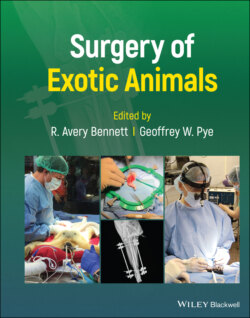Читать книгу Surgery of Exotic Animals - Группа авторов - Страница 123
Wound Healing
ОглавлениеEpithelialization, wound contraction, and tissue remodeling takes place in amphibians similar to in mammals (Poll 2009). In immature amphibians, skin healing involves contraction and regeneration of the skin, while postmetamorphic amphibians will form scar tissue devoid of dermal mucous and granular glands (Yannas et al. 1996).
During the inflammatory phase of wound healing, wet‐to‐dry bandages are contraindicated in amphibians because they may result in desiccation of the tissue surrounding the wound (Poll 2009). During the proliferative phase, becaplermin (Regranex®, 0.01% gel, Ortho‐McNeil Pharmaceutical Inc., Raritan, NJ, USA), recombinant human platelet‐derived growth factor has been suggested to accelerate healing (Walker and Whitaker 2003; Poll 2009). Apply the gel to the wound for 60 seconds every three weeks (Fleming et al. 2008). Before applying the gel, irrigate the wound with saline to loosen external debris, necrotic skin and exudates. Gently debride the area until a small amount of hemorrhage is observed and then rinse the wound again before applying a thin layer of gel (Poll 2009). After a contact time of 60–120 seconds, rinse the gel off or leave it on the wound. The use of hydrogel has also been recommended to accelerate wound granulation (Poll 2009).
